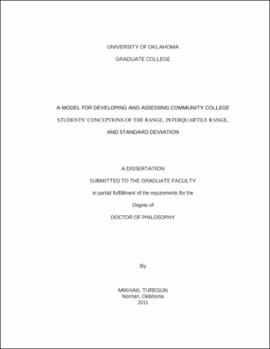| dc.contributor.advisor | Reeder, Stacy | |
| dc.creator | Turegun, Mikhail | |
| dc.date.accessioned | 2019-04-27T21:33:22Z | |
| dc.date.available | 2019-04-27T21:33:22Z | |
| dc.date.issued | 2011 | |
| dc.identifier | 99293702502042 | |
| dc.identifier.uri | https://hdl.handle.net/11244/318995 | |
| dc.description.abstract | Traditional curricular materials and pedagogical strategies have not been effective in developing conceptual understanding of statistics topics and statistical reasoning abilities of students. Much of the changes proposed by statistics education research and the reform movement over the past decade have supported efforts to transform teaching practices to include an emphasis on students' development of conceptual understanding rather than a focus on mechanical calculations (Chance & Garfield, 2002). In recent years, major research interest in the statistical understanding of students seemed to be focused on the measures of centers in distributions (Shaughnessy & Ciancetta, 2002). | |
| dc.description.abstract | Despite some very recent research studies investigating conceptual understanding of variability among community college students in introductory statistics courses, there are still several unanswered questions regarding how we, as statistics educators, can help students develop conceptual understanding of measures of spread at the community college level (Budé, 2007; Slauson, 2008). The purpose of this study is to investigate students' conceptual understanding of measures of spread and provide learning experiences and environments to support students in developing conceptual understanding of measures of spread, as well as to assess community college students' conceptual understanding of measures of spread. | |
| dc.description.abstract | In order to gain a broader and deeper insight into to my research questions, both quantitative and qualitative data were gathered, analyzed, and embedded in anaction research framework. The research focus was on investigating students' conceptual understanding of statistical measures of spread, and how students establish the connections between measures of spread and behavior of distributions of data sets. | |
| dc.description.abstract | A detailed analysis of the students' responses is presented to reveal the range of students' conceptions. My findings suggest that, despite the very limited mathematical andstatistical backgrounds, this particular group of community college students exhibitedat least some pre-existing conceptions of measures of spread, on which we, as statistics educators, need to capitalize in order to help students develop their conceptions further. This particular result both reinforces and is reinforced by constructivist/student centered theories, and indicates the applicability of these theories to college statistics students. | |
| dc.format.extent | 165 pages | |
| dc.format.medium | application.pdf | |
| dc.language | en_US | |
| dc.relation.requires | Adobe Acrobat Reader | |
| dc.subject | Statistics--Study and teaching (Higher) | |
| dc.title | A Model for Developing and Assessing Community College Students' Conceptions of the Range, Interquartile Range, and Standard Deviation | |
| dc.type | text | |
| dc.type | document | |
| dc.thesis.degree | Ph.D. | |
| ou.group | Jeannine Rainbolt College of Education::Department of Instructional Leadership and Academic Curriculum | |
